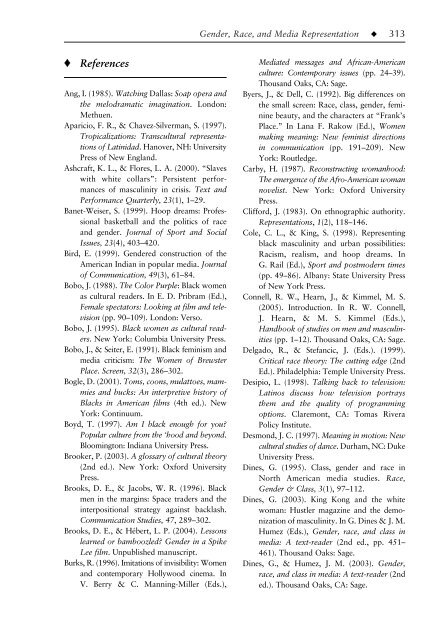Gender, race, and media representation - afghan
Gender, race, and media representation - afghan
Gender, race, and media representation - afghan
You also want an ePaper? Increase the reach of your titles
YUMPU automatically turns print PDFs into web optimized ePapers that Google loves.
16-Dow-4973.qxd 6/11/2006 1:42 PM Page 313<br />
♦ References<br />
Ang, I. (1985). Watching Dallas: Soap opera <strong>and</strong><br />
the melodramatic imagination. London:<br />
Methuen.<br />
Aparicio, F. R., & Chavez-Silverman, S. (1997).<br />
Tropicalizations: Transcultural <strong>representation</strong>s<br />
of Latinidad. Hanover, NH: University<br />
Press of New Engl<strong>and</strong>.<br />
Ashcraft, K. L., & Flores, L. A. (2000). “Slaves<br />
with white collars”: Persistent performances<br />
of masculinity in crisis. Text <strong>and</strong><br />
Performance Quarterly, 23(1), 1–29.<br />
Banet-Weiser, S. (1999). Hoop dreams: Professional<br />
basketball <strong>and</strong> the politics of <strong>race</strong><br />
<strong>and</strong> gender. Journal of Sport <strong>and</strong> Social<br />
Issues, 23(4), 403–420.<br />
Bird, E. (1999). <strong>Gender</strong>ed construction of the<br />
American Indian in popular <strong>media</strong>. Journal<br />
of Communication, 49(3), 61–84.<br />
Bobo, J. (1988). The Color Purple: Black women<br />
as cultural readers. In E. D. Pribram (Ed.),<br />
Female spectators: Looking at film <strong>and</strong> television<br />
(pp. 90–109). London: Verso.<br />
Bobo, J. (1995). Black women as cultural readers.<br />
New York: Columbia University Press.<br />
Bobo, J., & Seiter, E. (1991). Black feminism <strong>and</strong><br />
<strong>media</strong> criticism: The Women of Brewster<br />
Place. Screen, 32(3), 286–302.<br />
Bogle, D. (2001). Toms, coons, mulattoes, mammies<br />
<strong>and</strong> bucks: An interpretive history of<br />
Blacks in American films (4th ed.). New<br />
York: Continuum.<br />
Boyd, T. (1997). Am I black enough for you?<br />
Popular culture from the ‘hood <strong>and</strong> beyond.<br />
Bloomington: Indiana University Press.<br />
Brooker, P. (2003). A glossary of cultural theory<br />
(2nd ed.). New York: Oxford University<br />
Press.<br />
Brooks, D. E., & Jacobs, W. R. (1996). Black<br />
men in the margins: Space traders <strong>and</strong> the<br />
interpositional strategy against backlash.<br />
Communication Studies, 47, 289–302.<br />
Brooks, D. E., & Hébert, L. P. (2004). Lessons<br />
learned or bamboozled? <strong>Gender</strong> in a Spike<br />
Lee film. Unpublished manuscript.<br />
Burks, R. (1996). Imitations of invisibility: Women<br />
<strong>and</strong> contemporary Hollywood cinema. In<br />
V. Berry & C. Manning-Miller (Eds.),<br />
<strong>Gender</strong>, Race, <strong>and</strong> Media Representation–––◆–––313<br />
Mediated messages <strong>and</strong> African-American<br />
culture: Contemporary issues (pp. 24–39).<br />
Thous<strong>and</strong> Oaks, CA: Sage.<br />
Byers, J., & Dell, C. (1992). Big differences on<br />
the small screen: Race, class, gender, feminine<br />
beauty, <strong>and</strong> the characters at “Frank’s<br />
Place.” In Lana F. Rakow (Ed.), Women<br />
making meaning: New feminist directions<br />
in communication (pp. 191–209). New<br />
York: Routledge.<br />
Carby, H. (1987). Reconstructing womanhood:<br />
The emergence of the Afro-American woman<br />
novelist. New York: Oxford University<br />
Press.<br />
Clifford, J. (1983). On ethnographic authority.<br />
Representations, 1(2), 118–146.<br />
Cole, C. L., & King, S. (1998). Representing<br />
black masculinity <strong>and</strong> urban possibilities:<br />
Racism, realism, <strong>and</strong> hoop dreams. In<br />
G. Rail (Ed.), Sport <strong>and</strong> postmodern times<br />
(pp. 49–86). Albany: State University Press<br />
of New York Press.<br />
Connell, R. W., Hearn, J., & Kimmel, M. S.<br />
(2005). Introduction. In R. W. Connell,<br />
J. Hearn, & M. S. Kimmel (Eds.),<br />
H<strong>and</strong>book of studies on men <strong>and</strong> masculinities<br />
(pp. 1–12). Thous<strong>and</strong> Oaks, CA: Sage.<br />
Delgado, R., & Stefancic, J. (Eds.). (1999).<br />
Critical <strong>race</strong> theory: The cutting edge (2nd<br />
Ed.). Philadelphia: Temple University Press.<br />
Desipio, L. (1998). Talking back to television:<br />
Latinos discuss how television portrays<br />
them <strong>and</strong> the quality of programming<br />
options. Claremont, CA: Tomas Rivera<br />
Policy Institute.<br />
Desmond, J. C. (1997). Meaning in motion: New<br />
cultural studies of dance. Durham, NC: Duke<br />
University Press.<br />
Dines, G. (1995). Class, gender <strong>and</strong> <strong>race</strong> in<br />
North American <strong>media</strong> studies. Race,<br />
<strong>Gender</strong> & Class, 3(1), 97–112.<br />
Dines, G. (2003). King Kong <strong>and</strong> the white<br />
woman: Hustler magazine <strong>and</strong> the demonization<br />
of masculinity. In G. Dines & J. M.<br />
Humez (Eds.), <strong>Gender</strong>, <strong>race</strong>, <strong>and</strong> class in<br />
<strong>media</strong>: A text-reader (2nd ed., pp. 451–<br />
461). Thous<strong>and</strong> Oaks: Sage.<br />
Dines, G., & Humez, J. M. (2003). <strong>Gender</strong>,<br />
<strong>race</strong>, <strong>and</strong> class in <strong>media</strong>: A text-reader (2nd<br />
ed.). Thous<strong>and</strong> Oaks, CA: Sage.




